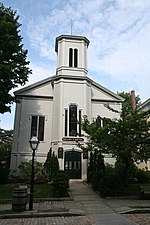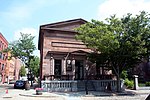Old Third District Courthouse
Buildings and structures in New Bedford, MassachusettsCounty courthouses in MassachusettsCourthouses on the National Register of Historic Places in MassachusettsGovernment buildings completed in 1853Greek Revival architecture in Massachusetts ... and 6 more
Historic district contributing properties in MassachusettsNRHP infobox with nocatNational Register of Historic Places in New Bedford, MassachusettsNew Bedford Whaling National Historical ParkRussell Warren buildingsUse mdy dates from August 2023

The Old Third District Courthouse in New Bedford, Massachusetts, United States, is located at the corner of Second and William streets. It was built in 1853 by Russell Warren in the Greek Revival architectural style, as the home of the New Bedford Institute for Savings, a local bank. After the bank moved, the Bristol County courts came in. They, too, eventually outgrew it and moved elsewhere in the city. Since the creation of New Bedford Whaling National Historic Park in 1996, it has been used by the National Park Service (NPS) as the park's visitor center.
Excerpt from the Wikipedia article Old Third District Courthouse (License: CC BY-SA 3.0, Authors, Images).Old Third District Courthouse
William Street, New Bedford
Geographical coordinates (GPS) Address Nearby Places Show on map
Geographical coordinates (GPS)
| Latitude | Longitude |
|---|---|
| N 41.635555555556 ° | E -70.923888888889 ° |
Address
New Bedford Merchant
William Street
02740 New Bedford
Massachusetts, United States
Open on Google Maps









